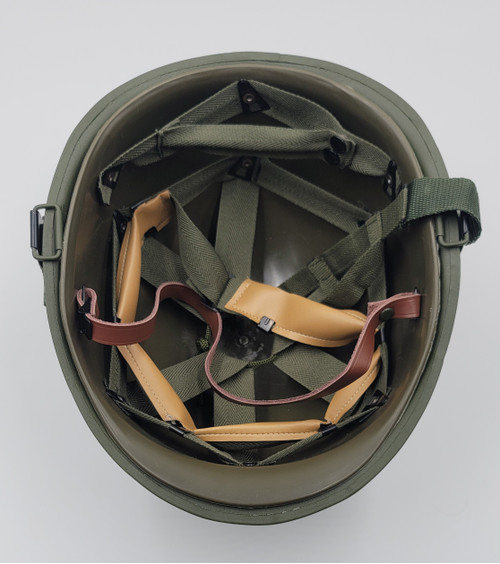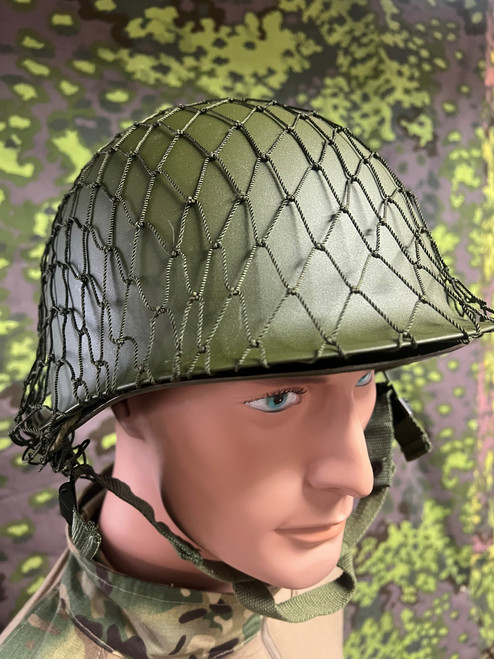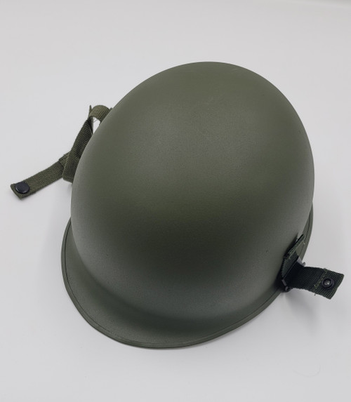A Crash Course on the US M1 Helmet
Apr 29th 2025
One of the most recognizable helmet designs in history, and with a long service history, the US M1 helmet is as recognizable a symbol of American involvement in WW2 as is the Garand rifle.
It is also one of the most influential steel helmet designs in history. Let’s take a closer look at this American icon.
About the US M1 Helmet
The US M1 helmet was actually the first American steel helmet design that was produced on a large scale. It was designed to replace the British M1917 Brodie helmet, better known as the “Tommy helmet” that was largely used to equip American troops on the Western Front in WW1.
The Tommy helmet, an English design, provided good overhead protection against shrapnel, but not the best protection from the front, the rear, or even the sides.
With that said, the M1 helmet was designed with the M1917 as a starting point. The wide visor was trimmed back, but the shell of the crown of the helmet was preserved. A flanged, skirt-like extension was added to the back and sides of the new design, along with a shorter visor in the front.
The new helmet, which would become the prototype for the M1 helmet, also rode lower on the wearer’s head, which afforded better protection against lateral fire. It also better protected the sides of the head and the base of the skull.
The new helmet was designed with a leather liner instead of a cradle-type system, and the US M1 helmet liner was actually developed from football helmet liners. An adjustable strap at the back helped prevent the helmet from rocking forward and backward on the wearer’s head.

Because of its unique steel pot and liner system, the US M1 helmet was effectively a “one size fits all” production, further streamlining mass production and adoption.
The shell of the US M1 was made from Hadfield steel, also known as manganese steel or mangalloy, which, once hardened, offered very high strength and abrasion resistance, in part due to its high manganese content, at up to 13%.
The shells of the first US M1 helmets were painted olive drab and treated with an application of finely ground cork. This improved the matte finish of the helmet and helped reduce reflectivity, which was believed to aid in keeping the position of a solder concealed.
The strength of the steel pot of the helmet was extensively verified during testing. The new helmet’s pot demonstrated an ability to stop a .45 ACP bullet fired at point-blank range, which actually exceeded testing expectations.
Therefore it goes without saying that the new M1 helmet offered considerable protection against small arms fire, even at close ranges.
Considering the high performance of the new helmet prototype, production commenced almost immediately after the design was approved in mid-1941, just before the entry of the United States into World War II.
Production rapidly scaled and more than 22 million M1 helmets were manufactured through 1945. McCord Radiator and Manufacturing Company pioneered a process to form the cupped shape of the steel pot through a single press, which greatly reduced manufacturing complexity, cost, and critically, time to produce.
In 1942, the design of the original US M1 helmet was changed slightly. The side brim was changed and the helmet bail was altered to a swivel model instead of a fixed and welded version. Additional changes came in 1944. Originally, the helmet was manufactured with a stainless rim, but from 1944, the rim was changed to a manganese rim with a rear seam.
Interesting Historical Tidbits About This American Steel Helmet
The US M1 helmet was equipped with a chinstrap to secure it on the user’s head, but this chinstrap was often worn clipped together at the back of the helmet, and not at the front.
Apparently, there were two reasons for this. One is that soldiers feared attacks from behind; if an enemy grabbed the helmet and pulled it backward while the soldier had the chinstrap fastened in front, this would expose the soldier’s throat. Wearing the chinstrap fastened at the back meant that if an enemy grabbed the helmet from the rear, the helmet would just come off.
The other reason is that there was a widespread fear among American soldiers that wearing the helmet fastened properly would expose the wearer to a risk of percussion shock or even fatal injury if there were an explosion nearby. This was however an erroneous assumption.
Another interesting fact about US M1 helmets is that they had a somewhat nondescript bowl shaped design, especially when compared to many other comparable steel helmets of the era. For this reason soldiers often removed the steel pot and used it for less conventional uses.
For instance, it has been said that the steel pot was often used, when separated from the chinstrap and liner, as an entrenching tool, as well as a washbasin, a bucket, or a bowl. The steel pot could also be used as a striking implement, such as for the purpose of driving stakes, and it could be used as a makeshift seat. Apparently, the pot could also be used as a shaving basin.
Evidently, the steel pot could also be used for cooking, since it could hold nearly a gallon of water, but this practice was not widespread and was not encouraged because exposure to heat could alter the physical properties of the manganese steel, making it brittle.

Shop Army Surplus Here
Here for a US M1 helmet, liner, or some other army surplus? Shop our collections via the links here. In addition to US M1 helmets and liners, we also carry M1 helmet nets, chinstraps and other accessories.
For more information take a look through our full collections and if you are looking for a specific piece of military history, or army surplus that you don’t see listed on our website, don’t hesitate to get in touch with us at 610-250-3960. We carry thousands of gun parts and military collectibles, and would be more than happy to help you find what you’re looking for.

